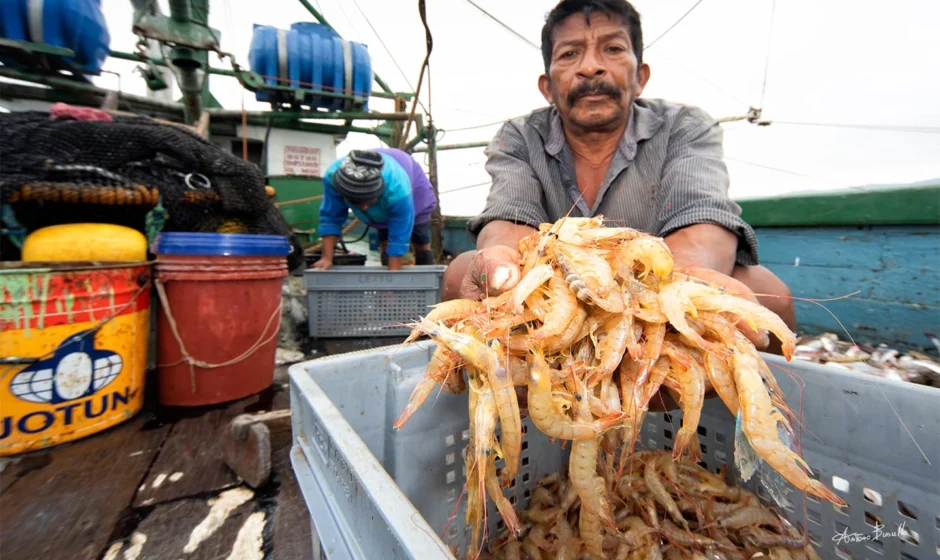A crippling tariff imposed by the United States has plunged India’s vibrant shrimp export sector into an unprecedented crisis, threatening a multi-billion-dollar industry and the livelihoods of millions. With the American market, the largest buyer of Indian seafood, now virtually inaccessible, a radical new strategy is no longer a choice but a necessity: strategic offshore investment. For beleaguered Indian seafood companies, the most viable and potent solution may lie thousands of miles away, in the aquaculture powerhouse of Ecuador.
The Perfect Storm: A Market Paralyzed
On August 6, the Trump administration’s decision to levy an additional 25% tariff on a range of Indian imports, including seafood, was a devastating blow. This came on top of existing duties, raising the total tariff barrier to a commercially unsustainable level of nearly 50%. The impact was immediate and profound. The US market, which accounted for approximately $2.5 billion in Indian seafood exports in FY2024—with shrimp comprising an overwhelming 92% of that value—was effectively priced out overnight.
This sudden market closure creates a painful ripple effect that extends far beyond the corporate balance sheets of large exporters. It jeopardizes the entire value chain: the small-scale farmers who cultivate the shrimp, the hatchery operators who supply the seed, the feed manufacturers, the processing plant workers, and the logistics networks that support them. Furthermore, it deals a significant setback to the ambitious targets set by the Marine Products Exports Development Authority (MPEDA), which aims to achieve a seafood export turnover of $18 billion by 2030—a goal now in serious jeopardy.
The domestic market, despite its size, cannot absorb the surplus. Indian consumers do not have the appetite or the purchasing power for the vast quantities of high-value, export-quality shrimp previously destined for American restaurants and retailers. While the government fully opened the sector to foreign direct investment (FDI) in 2016, a substantial influx of capital from abroad has failed to materialize, leaving the industry with limited options for domestic expansion. This reality forces a pivot from seeking investment at home to deploying it abroad.
The Ecuadorian Advantage: A Strategic Lifeline
Investing in Ecuador is not about abandoning Indian operations, but about executing a brilliant strategic bypass. It allows Indian companies to transform a geopolitical threat into a global business opportunity. Here’s why Ecuador represents such a compelling case:
- Tariff and Trade Arbitrage: The most immediate benefit is circumventing the crippling US tariffs. By producing shrimp in Ecuador, Indian companies can export to the United States under Ecuador’s more favorable trade terms, instantly restoring their competitiveness and preserving their hard-won market share.
- Unmatched Production Prowess: Ecuador has, in recent years, established itself as the world’s most efficient and formidable shrimp producer. Its aquaculture model is built on large-scale, low-density farming systems that minimize disease risk and maximize animal welfare. This, combined with advanced genetics, superior feed conversion ratios, and lower operational costs, makes Ecuador the global benchmark for producing raw shrimp at a competitive price.
- Marrying Indian Expertise with Ecuadorian Efficiency: While Ecuador excels at producing high volumes of raw shrimp, India has developed a sophisticated industry focused on value-added processing. Indian firms are masters at creating products like cooked, marinated, breaded, and ready-to-eat shrimp tailored for global retail and food service clients. An Indian-owned facility in Ecuador could marry world-class Ecuadorian raw material with India’s renowned processing expertise, creating an unbeatable combination of quality, innovation, and cost-effectiveness.
- A Pro-Business Environment: Ecuador has a well-established aquaculture infrastructure, a supportive government framework for foreign investors, and a skilled workforce. For Indian companies, this means the ability to establish or acquire operations—whether through joint ventures, outright acquisitions, or greenfield projects—in an ecosystem that is built for success.
The Way Forward: From Exporter to Global Player
The move into Ecuador is more than just a defensive reaction to a trade dispute. It represents a paradigm shift for India’s seafood industry—an evolution from being a national exporter to becoming a truly global multinational player. By diversifying their production base, Indian companies can de-risk their operations from the volatility of geopolitics and protectionist trade policies.
Such an investment will undoubtedly come with challenges, including navigating a new regulatory landscape, managing cross-cultural operations, and competing with entrenched local players. However, the potential rewards are immense. Indian firms can gain invaluable insights into Ecuador’s cutting-edge farming techniques and bring that knowledge back to improve domestic operations. They can build a resilient, globally integrated supply chain that can pivot between markets as conditions change.
The tariff crisis, while painful, may be the catalyst the industry needed. It has exposed the vulnerability of being heavily reliant on a single market. The bold, forward-thinking Indian companies that invest in offshore production in hubs like Ecuador will not only survive the current storm but will emerge stronger, more diversified, and better positioned to lead the global seafood industry for decades to come. The future of Indian shrimp will be defined not just by what is “Made in India,” but by what is “Managed and Owned by India” across the world.


